Remembering Michael Armstrong
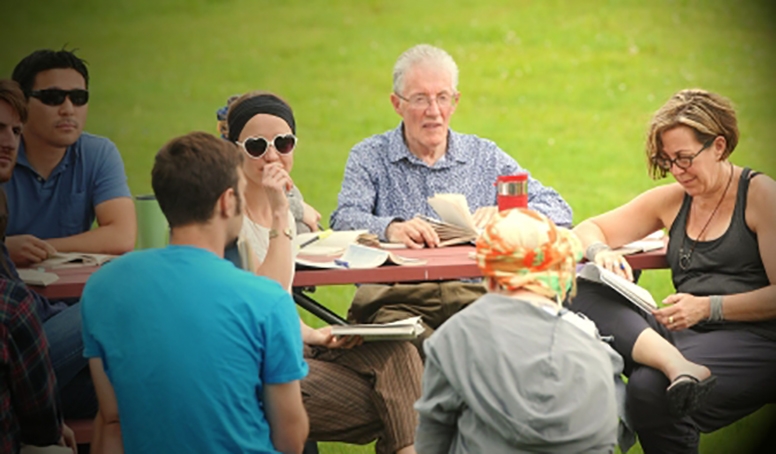
f you are one of the more than 4,000 students who attended Bread Loaf between 1986 and 2015, chances are you have heard of the late Michael Armstrong. His courses on the pedagogies of imagination, narrative, Calvino, and storytelling were transformative, his delighted engagement with the community all encompassing, his philosophies of education powerfully influential. And if you are one of the nearly 600 students who were fortunate enough to take a class with Michael, you experienced firsthand the might of his genius, imagination, interest in the work and minds of his students, and ability to inspire.
When faculty, students, staff, and other friends gathered together at the Vermont campus last summer to celebrate Michael’s life and work, they emphasized the reaches of his imagination and exuberance. Bread Loaf faculty member David Huddle composed a roman-à-clef short story for the occasion: “The Professor of Levitation.” Wherever the protagonist went, writes Huddle, “people felt peculiarly uplifted, an upgrade of dignification. They had been ‘betterized.’ ‘How did that happen?’ they’d ask themselves.”
We might never find the answer to just how Michael lifted us up to our best selves. But we’ve gathered here some of the memorable voices from that evening in the spirit of collective celebration and gratitude for the buoyancy Michael Armstrong offered us.
Invisible Cities of Strength
By Laura Benton, current student
Last summer, I had the privilege of taking Michael Armstrong’s Calvino class. For my final project, Michael allowed me to write a unit plan for one of our most beloved texts, Invisible Cities.
When I went home to my students in Kentucky, I couldn’t wait to teach this book. And sure enough, the students in my creative writing class loved it. They loved Invisible Cities because it is beautiful and heartbreaking, but also because Michael taught mehow to loosen up and trust my students and their imaginations. I stopped worrying so much about completing individual lessons, and focused entirely on student engagement and interest. I let them pick what they wanted to do, and how they wanted to discuss the book.
Then something magnificent happened. My students and I stopped talking about Calvino, and started asking questions about the Invisible Cities in our community. We took the book we were reading and found a way to apply it to our lives. Together, we decided to spend our time in class, writing a book about six invisible cities, or rather disappearing historical communities in our own Woodford County, Kentucky. This project (like all BLTN projects) started small and became huge. I would like to take a moment and share the end results of that project with you today. This is a digital copy of our book. We produced both physical copies and digital.
Together, my students…
- wrote a 150 page book that combines historical non-fiction, poetry, prose and photography. This book tells the story of our six invisible cities. We have currently sold over 100 copies of the book as part of our class fundraiser.
- Created physical displays that exhibit each of the invisible cities. These exhibits were set up at our local community festival Spark. At this festival they were seen by over 1,500 members of the community. They were then set up in the school and stayed in the front lobby for several months.
- Wrote a play based on the real life stories of these invisible cities and presented it at our community festival to an audience of over a hundred people.
In the end, this project joined together five high school classes across disciplines (history, science, engineering and English) and sixty students. Together we discovered that learning is an imaginative, collaborative, multimodal, and interdisciplinary experience. By which I mean, we learned to be readers, historians, researchers, designers, photographers, writers, editors, engineers and builders. We learned that the differences in our imaginations make us stronger.
That’s the thing about changing the world. It starts out with one person, one attitude, one belief, one book, one opportunity—to take the positivity and imagination that Michael imparted to me, and give it back to someone else. Because when you teach teachers, something that so many of you in this room do so brilliantly and with such passion, when you impact and change the life of a teacher, they impact and change the life of their students. The work that Michael Armstrong did, is incalculable. He gave me a book that changed my life. And then I gave that book to my students. Is there anything more significant that one human being can do for another? Brains love books.
So I would like to end with a quote from one of my students.For part of their final, I asked my creative writing class to reflect on their work in reference Invisible Cities. This is Natalie Heigel, holding a picture of her historical invisible city, Pisgah. This is what she had to say.
“In every avid reader’s life, there comes a book that completely changes their perspective of this world, sometimes even going so far as to change the individual themselves. Invisible Cities by Italo Calvino was that book for me. Like the city of Ersilia, in which relations are shown by an endless maze of string, there exists an innumerable amount of connections between Invisible Cities and I, making me stronger than I could have foreseen.”
Thank you Michael for making all of us all stronger.
Michael Closely Observed
By Julie Bernson, Deputy Director for Learning and Engagement deCordova Sculpture Park and Museum, Lincoln, MA
Michael was a mentor, a friend, a colleague, and as such, an enormous inspiration in my life as an art museum educator. His understanding of art was as profound as his understanding of children. His excitement for professional artists and museum exhibitions was on a par with that of children’s cultural production.
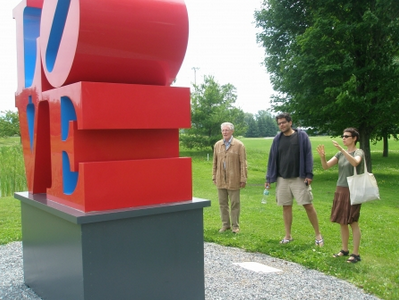
I was privileged to read his revolutionary writings, listen to him teach and speak, and collaborate with him on educational projects. I had the incredible opportunity to observe him in classrooms in Lawrence - which was to witness his unwavering commitment to learning from students and from teachers alike. And to work with him on designing and publishing “What Children Know” in order to give equal importance to the visual image and the written word.
These images illustrate just a few of the many classrooms in which he simultaneously researched and participated — learned and taught — making his quiet yet indelible mark on the students and teachers in his midst — and developing the profound ideas and essays that will live on to inspire generations of teachers and students around the world.
Michael the Teacher
By Michele Stepto, Bread Loaf faculty member
I want to talk today about Michael’s gifts, not so much the ones he possessed, though they were considerable, but the ones he gave to us as colleagues and students, gifts of understanding. And in particular, I want to talk about Michael’s teaching. What I learned from Michael about teaching was immense, incalculable.
I sat in four of Michael’s classes during our years together here. The first was called simply Storytelling. I was interested in the book list, which included Silko’s the Storyteller and Calvino’s collection of Italian fiabe, which I loved, but mostly I was interested in the subject of storytelling. This would have been in the early 2000s, during a time when I was feeling as if I had lost the ability to tell any story at all. I remember distinctly how his class unleashed an outpouring of stories from me, so that was a great gift that Michael gave me. Stories could be made out of anything, and out of almost nothing, which is what I felt in possession of at the time.
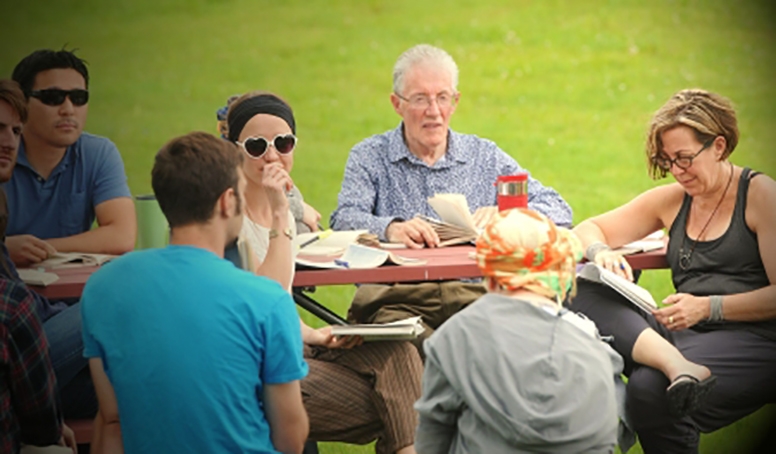
But the other thing I learned in that class was that Michael was an extraordinary teacher. For one thing, he could draw every last student, no matter how shy or taciturn, into the circle of discussion. I was determined to understand how he did this, so I went right on auditing his classes, on the imagination, on War and Peace, on Italo Calvino. I was looking forward to sitting in on his Folktale course this summer, as were so many of you, to read one of my favorite genres with Michael and to learn more of his teaching secrets.
We’re all teachers here, and so we all know how difficult it is to knit together what you want to say to your students and what they themselves want to say. And in a literature classroom, they have a lot to say and what they want to say can be astonishingly disconnected from what you feel they need to know. The transition between these two projects—teaching the subject and allowing for student expression—can be very rocky. Too often, we navigate it by inviting students to guess what’s in our minds. Not a good idea, as we’ve all discovered. For many years I simply presented what I wanted to present, filling up the blackboard with ideas I wanted the students to write down, and then when that was all over letting them know that it was “their turn.” Now they could talk about whatever interested them in the text. Usually some of my ideas came back at me, but not always—and when that happened I was not above pointing out that this or that remark a student had made was related to what I was mentioning earlier, gesturing vaguely at the blackboard behind me. It sort of worked, but it wasn’t satisfying, not like Michael’s classes, and when their turn came too often the same handful of students had their hands waving in the air, Hermione-Granger-like, while someone else was speaking. Definitely not like Michael’s classes, and far from ideal.
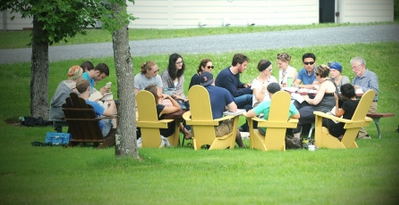
One of Michael’s teaching secrets had to do with something I’ve already mentioned: the circle. There are circles powerful forming all the time here at Bread Loaf, and among the most powerful I have entered were the circles Michael gathered in each of his courses and nurtured as the summer went on. In the opening Imagination class, he asked us to think for a moment and then describe an object we had left at home. Or he would begin a class session by asking us to answer a simple question about the text at hand by choosing a particular passage. For example, What passage seems to you to lie at the heart of this text? He would give us a few minutes to study the text, and then we would go around, speaking in turn and otherwise listening. In these circles, everyone spoke. There was no pass, not even for the mortally shy, and no holding forth for the big egos in the circle. It never took long. Everyone understood it was an opening move, or better yet, an opening gift deposited in a gift circle along with other gifts.
One of the gifts Michael gave to me was an introduction to the work of Lewis Hyde, who writes in his book The Gift, that in such a circlethe gift does not perish in being given away, but remains and returns as part of something larger:”When the gift moves in a circle,” he writes, “its motion is beyond the control of the personal ego, and so each bearer must be a part of the group and each donation is an act of social faith.” Sometimes Michael would ask a second “circular question,” typically after a break, to remind us of the circle already begun. Out of class, where the circle persisted, Michael’s students were aware of belonging together to something greater than themselves. In class, they took from the gift circle what seemed right to complete their thoughts and in turn gave back a slowly perfecting vision of the material. When the term ended, this circle, full and unique for each course, each summer, is what we took with us.
Surely the circle is something Michael perfected teaching little children, whose egos are not yet fully formed and who, most of them at least, still delight in belonging to something larger than themselves. Most primary school teachers have some version of this style, but as we go up in the grades, it drops away and we find the individual ego dominating, both in the teacher and in class discussion, and celebrated in the texts we ask students to read. I have found myself saying, Let those who want to talk, talk, and as for the silent ones let the chips fall where they may. This is wrong. Everyone deserves to be part of the whole, even those who treasure their outsider status, perhaps especially those.
Michael worked on this from the first day of each class, I can see now, and with spectacular results: people passionately remember being part of one of Michael’s classes, which tells me that they continue to belong. But when did Michael have a chance to say his say? Where was this learned man in the gift circle he set flowing? Well, surely, those opening questions he asked were gifts. I’ve suggested two of them, but in truth it’s hard to remember them because they so quickly blossomed into a complexly authored arrangement of the subject matter, as Michael intended they should. I don’t ever remember Michael stopping things to say something that he felt needed to be said but hadn’t been. Perhaps in his instructions for the next class meeting (he often gave those) he might point us in a direction he thought we’d missed, but I think he felt satisfied for the most part with the discussion that opened and grew and deepened and expanded as each course progressed, and in which his comments joined everyone else’s in a widening understanding.
We’ve all had the experience of looking back on a term and saying, That was a good course! And we’re not talking about ourselves when we say that. We’re talking about something beyond ourselves and beyond any one student in the class. I think Michael often experienced that kind of teaching satisfaction, without ever insisting on his point of view in any of the classes I sat in on. That takes courage. That is an act of social faith.
Calvino and Beyond
By Sarah Getchell MA ‘14
When we were with Michael in class, we were often our most childish selves and our most erudite selves. We were a group of eager and brave children who forgot the adult skins we inhabited as we climbed up the ladder to the moon. We felt safe making comments about how the cities in Invisible Cities, when plotted, form a perfect sine curve (this was an actual comment made in my Calvino class, to which Michael replied “well, I’m afraid you’ve lost me entirely, but I find this very interesting”), or scratching our bug bites while answering a question, or spinning because it just felt right while portraying the mystical and voluptuous Mrs. Vhd Vhd in a skit. We were freed from concerns about impressing the unimpressible or creating a failed work, and were therefore able to reach higher creative and analytical pinnacles than we thought possible, in a way that often seemed effortless (or “light” as Calvino might say) because we weren’t driven to achieve by fear, or the desire for an A. Michael gave us this environment, and this way of living, teaching, and valuing the beauty of art and the beauty of humans, and he didn’t do it by being undiscerning, but by tempering discernment with love, humor, and delight.
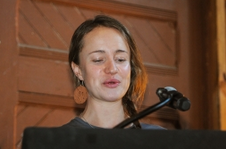
I knew Michael as the gentle, powerful, and glowing teacher of the Calvino and Beckett course that I took in 2014, my final year as a Bread Loaf student, but I also knew him as a neighbor who allowed me to escort him on occasion to dinner or to pond readings, as a committed audience member at Blue Parlor, as the teller of stories around a bonfire, as a witty and highly responsive pen pal, as a Bridgeman-porch confidante, and as a nearly mythical figure whose elevated status paradoxically came from his ability to elevate us and to make us realize that we are ALL creators and that this, both Bread Loaf and Earth, is the setting for our own epic journey of art, literature, and experience.
I’ve heard professors speak about the fact that one of the things that makes professing at Bread Loaf so special is the awareness that many of their students are also teachers, which means that the experiences in Bread Loaf classrooms have exponential effects on classrooms across the country and world. In my research for this speech I got to follow some of the echoes of Michael’s impact, and I received gorgeous emails, letters, and Facebook messages about the superlatively significant changes Michael made in the lives of his students and the in lives of his students’ students, and even, in one case, his student’s student’s students. I’m going to share a couple of these anecdotes with you now:
Noam Osband MA ‘13 wrote this:
“I never spoke to him until 2009. I was convinced he was a very stern Englishman and uptight which is so absurd if you knew him. The summer of 2009, I was taking Dixie’s multimedia class. I was doing a project on digital literacy and I interviewed him on camera for it. We asked him what he thought of text-speak and new modes of communication that come with the phone. I was so sure he was going to be sour about them. Instead, he immediately responded, ‘I find this tremendously exciting’ explaining that it gave kids new ways of expressing themselves. I’ve never forgotten that. I hope I’m as intrepid with technology when I’m his age.”
Amy Lafty MA ‘14 wrote this:
“There is a lot I could talk about when it comes to Michael, but I’ll leave you with this- a few weeks ago my four year old son graduated from pre-k and received the imagination award. My heart beamed, I closed my eyes, and thought—I would give anything to share this with Michael.”
Claire Brislin (current student) said this:
“One of the most impactful things about Michael was his belief that EVERYONE is a creative being, that this is our essence. His absolute, unquestioning belief in this was incredibly powerful.”
Himali Soin (current student) assigned Michael the strange and wonderful superlative, “most likely to be a ghost or a fairy, or maybe a radiant photon entangled in some cosmic current flying all around us, his feelings giving him form in the afterlife.”
Ben Courchesne MA ‘12 messaged this:
“Michael’s classes were always platforms for his students. Michael told us that Calvino told us that ‘every story has a magic object,’ something that unlocks or advances or reveals a relationship between characters or between a character and the world. I remember Annie’s gold spider necklace and Will’s ‘No one likes Kant’ necklace, Kieran’s stuffed rabbit (Bufford), etc. I remember Michael describing in a small, soft voice his fancy Italian coffee maker he could not live without.”
Like these other former students of Michael’s, I find it impossible to sum up the impact that Michael has had on me as a person and as an educator but I’m going to try, right now.
I teach at a private school in Cambridge, Massachusetts where many students go on to top-ranked universities and where students approach school in a very goal oriented, professional, and often joyless manner (they are quite self aware and will tell you this themselves). Each year, I begin my core classes with Michael’s wonderful essay “The Pedagogy of the Imagination,” which includes Michael’s critical analysis of the work of an eight year old from a public school in Lawrence, MA, a town very near Cambridge but of which many of my students have never heard. Many of my students are initially angered and threatened by the use of the word “literature” to describe the work of an eight-year-old. But by the end of the year Michael’s lesson has reached them, and they let me know that his words empower them to be “real writers,” to be both more playful and more serious about their work, and to value the works of others, even those outside the cannon, even the voices of children, more highly.
Michael allowed one of my former students who was struggling with drug addiction to sit in on a class. The discussion of “The Cheese Museum” from Mr. Palomar had such an impact on this young man that he enrolled in community college English courses and, when he learned that they weren’t going to read literature in the courses, had a private meeting with a professor about the transformative effects of reading together. When asked, my former student suggested Calvino as the first author that they should read.
I think that Michael’s greatest gift to me was the revelation that the love of literature and equality go hand in hand, that human lives need to be narrated, and that narration can give voice to the voiceless, even the voiceless dead.
Last summer, when the Andover Bread Loaf folks were visiting, Michael strongly and publicly stated that private schools should not exist. This comment opened up a dialogue between us about equity and access to education that lasted into the winter. In January, I wrote to him about a debate that took place at an international competition that I was judging in which private school students from around the world had to defend or refute the resolution: “All private schools should be abolished and banned.” I also told him, offhandedly in the same email, that one of the students in my junior class had purchased a pair of distance of the moon socks after we read Calvino together. He gave me a thoughtful response about the international debate, but told me that his favorite part of my message to him was the part about the socks. Michael taught me that it is not only possible, but imperative, that we continue to wrestle with impossibly complex issues of social inequality while retaining the emotional space and lightness to be delighted by a pair of socks.
When I introduced Michael at a pond reading last year, I said that he brings us closer to the moon, but this is not entirely accurate. I think, more rightly, he makes (yes, present tense, MAKES) us look at pieces of granite right here like moon rocks, and at each other like the miraculous and bizarre characters in a Calvino story, each infinitely interesting, each worth the risk of an impossible leap to the moon, each as valuable as the next. Thank you Michael, for making me, and so many others, more radical, more gentle, and more delighted.
